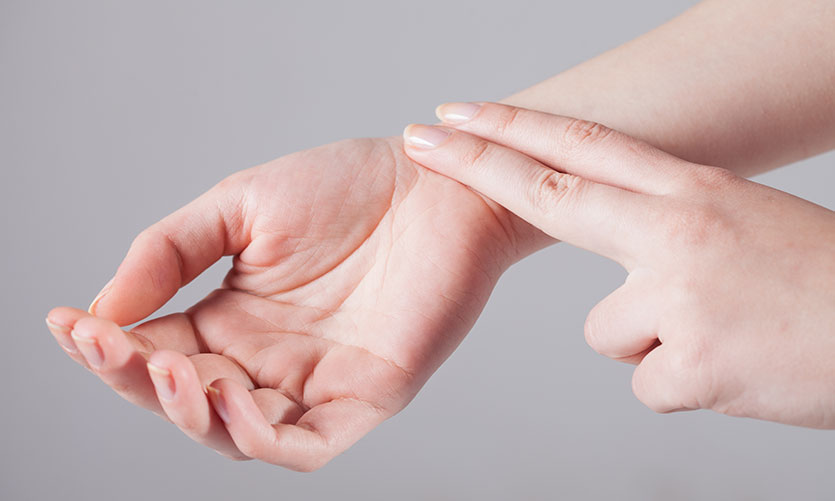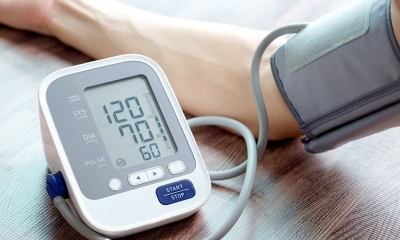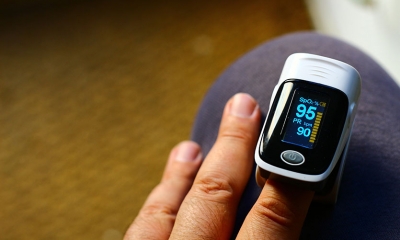Measures of Health: Learn to Track 5 Main Health Indicators
Staying on top of your health requires more than seeing your healthcare provider for an annual check-up. It means monitoring key health indicators frequently at home. These measures can help you meet the World Health Organization’s definition of health: a state of complete physical, mental, and social well-being—not just the lack of a disease. And that’s why tracking your health data can be an important tool for maintaining your overall health and wellness.
There are five main health checks (called vital signs) that are regularly assessed whenever you see a physician. But you can also track these important measures of health—and more—at home.
Blood Pressure
This simple health indicator of the cardiovascular system measures how hard your heart has to work to pump blood through arteries and throughout your body. It measures the force of blood pushing against the blood vessel walls. High blood pressure (called hypertension) is often referred to as the “silent killer” because there are typically no symptoms associated with this condition.
Regularly measuring blood pressure is so important that there are published guidelines on how to take it properly. And healthcare professionals must routinely learn to take blood pressure measurements correctly during their education. While the manual measurement of blood pressure using a mercury sphygmomanometer (also called a blood pressure cuff) and a stethoscope has long been held as the gold standard, automated devices are now routinely used in clinical practice.
These automated blood pressure machines are the easiest way to track your blood pressure at home and monitor cardiovascular health. This type of device includes a digital monitor that displays blood pressure results (numbers) on a small screen. The top (or first) number displayed on the screen is called the systolic number, which indicates the pressure inside the artery when the heart is contracting (or pumping blood). The second (or bottom) number on the screen is called the diastolic number—the measure of the pressure inside the artery when the heart is resting in-between beats.
Higher numbers can indicate that the heart is working extra hard to pump blood through your arteries. This may be the result of a temporary external influence—like feeling stressed, scared or excited. It could be the result of heavy exercise that causes a temporary rise in blood pressure to increase flow to deliver extra oxygen and essential nutrients throughout your body.
Or the high number could be caused by an internal force, such as the buildup of plaque in arteries. This can cause blood vessels to become narrowed and less flexible over time.
The American Heart Association (AHA) recommends selecting an automatic, upper arm (bicep) cuff digital blood pressure monitoring device. It’s important to do your research and select a machine that fits your arm and that has been validated for accuracy. Your physician or a pharmacist can help suggest the best type of device for you to use at home. It’s also important to read and follow all instructions and directions provided for setting up your new blood pressure device or have your healthcare provider show you how.
Taking one blood pressure measurement tells you what your blood pressure is right now. It’s not an accurate measurement of overall cardiovascular health. Checking blood pressure routinely, whether that means daily, or a few times a week is a much better indicator. Readings can also vary depending on the time of day, the activity you may have just completed, if you are stressed or even sick. That’s why it’s important to record the results to better track your health data. It’s also preferable to measure blood pressure about the same time each day.
Tips for Taking Your Blood Pressure
For better accuracy it’s important not to smoke, drink caffeine and alcohol, or exercise within 30 minutes of checking blood pressure. It’s also helpful to sit quietly with your back straight and supported (a chair works well) for 5-10 minutes first to help you relax. Place your feet are flat against the floor and don’t cross your legs.
The arm you’re using to measure blood pressure should be resting on a flat surface (a table works well) with the upper arm positioned at the level of your heart with the palm of your hand facing up. Position the cuff so that the bottom edge of the cuff is placed directly above the bend of your elbow, and try not to take a measurement over clothes. Take two or three readings about one-to-two minutes apart and record the date, time, and results each time you measure your blood pressure.
What Your Numbers Mean
A healthy, normal blood pressure is considered anything less than 120/80. Your blood pressure could vary depending on your gender, age, weight, and any medical conditions you have. If you do register a blood pressure reading that’s higher than ideal, wait two to five minutes and recheck. Consult your physician if you consistently have higher blood pressure. A higher pressure reading means the heart is working extra hard to pump blood out to circulate throughout your body. A chronically elevated blood pressure is called hypertension and it’s known to contribute to a variety of health conditions.
Healthcare experts from the American Heart Association, the American College of Cardiology, and many others officially updated guidelines for blood pressure numbers in adults in 2017. These new definitions lowered the numbers used for making a diagnosis of hypertension. This means many people who were not previously considered to have high blood pressure are now considered to be hypertensive.
| 2017 Updated Blood Pressure Categories | |||
| Systolic | Diastolic | ||
| Normal | Less than 120 | and | Less than 80 |
| Elevated | 120-129 | and | Less than 80 |
| Hypertension- Stage 1 | 130-139 | or | 80-89 |
| Hypertension- Stage 2 | 140 and higher | or | 90 or higher |
| Hypertensive Crisis | Higher than 180 | And/or | Higher than 120 |
Data obtained from the American Heart Association
Blood flow is your internal transportation system designed to distribute oxygen and essential nutrients throughout your entire body. That’s why it’s so important to make sure this system runs smoothly. Tracking your blood pressure results over time provides a “snap-shot” of your heart health. And this information may provide the needed motivation to improve lifestyle measures known to support healthy blood pressure and overall heart health. It may also motivate you to consult with your healthcare provider to determine the best treatment options for higher blood pressure numbers.
Heart (or Pulse) Rate
Heart or pulse rate is a measurement of how many times your heart beats (complete heart-muscle contractions) in one minute. Measuring your heart rate is considered an indicator of heart muscle function and is another important measure of health.
A resting heart rate is how many times your heart beats while you are rested or relaxed. This number is different from the amount of beats that occur when you are physically active or stressed. The average heart rate for a healthy adult is between 60 and 100 beats per minute. But age and activity levels can influence heart rate. It may be higher when exercising and lower during times of inactivity. Other factors that can influence heart rate include stress and anxiety, caffeine or other stimulants, certain medications, body position (standing, sitting or lying down), body temperature, and some medical conditions.
How to Check Your Heart Rate
You can check your heart rate at your wrist or on the side of your neck using two fingers. Alternatively, you can see your heart rate measurement when checking blood pressure with a digital blood pressure monitoring device, when using a pulse oximeter to check oxygen saturation levels, and on a smart watch, wearable, or app.
To check your pulse rate using your wrist, use the index and middle finger of your dominant hand and position them so that the tips of the two fingers align. Press them lightly on the inside of your opposite wrist just below the base of your thumb in the soft space under your wrist bone to feel the radial artery beneath the skin. When monitoring pulse rate in the neck (carotid artery), lightly press the same two fingers on the side your neck, just beneath the jawbone to the side of your windpipe.
Count the numbers of beats for 15 seconds and multiple that number by four to see your heart rate. For the best accuracy, repeat this procedure two or three times and use the average of these numbers.
Numerous watches and smartphone apps can track various elements of health. And many provide heart rate monitoring so that you can check your heart rate at a glance. However, there is no guarantee of accuracy because they aren’t required to be medically validated.
Respiratory (Breathing) Rate
Respirations occur when you breathe in and out. Breathing provides the oxygen required for every cell in the body to function properly. During the respiration process, air is moved in and out of the lungs. This process facilitates gas exchange by bringing oxygen in and pushing carbon dioxide out.
A respiratory (breathing) rate is the number of breaths taken in one minute. And it’s easy to measure. Respiratory rate is measured by counting the numbers of breaths taken (the number of times your chest rises and falls) for one minute. Remember that one rise and one fall are counted as one breath.
When checking respiratory rate, it’s best to sit upright in a chair. But it can be measured lying down if needed. A healthy adult respiration rate is between 12 to 20 times a minute.
Body Temperature
Your body has an internal thermostat and its proper functioning is important. That makes temperature another important vital sign used to assess overall health. Temperature checks are a routine part of any visit to a healthcare provider. But it can also be checked at home if you or a loved one isn’t feeling well, or are just curious what your temperature is. It’s easy to check body temperature with a thermometer.
Your body does a good job of regulating body temperature to keep you healthy. And it’s normal for it to fluctuate in a healthy range throughout the day and throughout your life. Body temperature is also influenced by age, gender, certain medicines, and diseases.
You’ve probably heard the right body temperature is 98.6 degrees Fahrenheit (or 37 degrees Celsius). It was long considered the normal number for assessing a healthy temperature based on data from as early as the 1800s. But newer research shows that a normal, healthy adult temperature can range significantly, averaging between 97 and 99 degrees Fahrenheit depending on the person.
How to Pick Your Thermometer
There are options when it comes to choosing a thermometer to check body temperature at home:
- A digital thermometer uses electronic heat sensors to record body temperature. This no-contact thermometer is typically used to measure temperature when pointed at the forehead.
- A digital ear thermometer (also called a tympanic thermometer) uses an infrared ray to measure the temperature inside of the ear canal.
- A temporal artery thermometer uses an infrared scanner to measure the temperature of the temporal artery in the forehead. This thermometer is gently swiped across the forehead lightly touching the skin. It should be cleaned between uses.
- The mercury thermometer is no longer recommended due to the possibility of the glass getting broken and allowing the toxic mercury to escape and cause contamination. Digital, oral thermometers are good replacements for those used to this type of device.
While thermometers are available in a variety of styles, it’s important to note that not all thermometers provide the same quality and accuracy. So if you’re not sure which one to buy, ask your pharmacist or physician for advice on selecting the best thermometer for home use.
Oxygen Saturation (SpO2)
This metric of health measures the amount of oxygen in red blood cells—also referred to as oxygen saturation. Your body closely regulates your blood-oxygen levels because maintaining a precise balance is vital for health.
A measurement of your blood oxygen is called an O2 Sat (SpO2) when using a pulse oximeter—a noninvasive way to obtain this important measure of health. Pulse oximeters are typically small electronic devices that clip on the end of your index finger. This vital sign is another metric of health that’s routinely checked when you visit a healthcare provider.
A normal, healthy pulse oximeter reading typically ranges in the mid 90s up to 100 percent. A value below 90 percent is considered low and should be medically evaluated by a healthcare professional.
Pulse oximetry is also used in athletic training and can also be found in gyms and fitness centers. It can provide important information for athletes and amateurs during workouts to help improve endurance, speed, and overall performance.
Advances in technology and direct-to-the-public sales have made it easy to purchase a variety of medical-type devices without the need of a doctor’s order. This includes pulse oximeters. When choosing a device, it’s important to buy it from a reputable company and check to see of the device has been clinically validated for accuracy, otherwise it could be a waste of time and money.
Pulse oximeters have the technology (depending on the brand and model) to measure important vital signs including: oxygen saturation, pulse rate, breathing rate, and more from a fingertip. All these health indicators can help you support your respiratory health. Although SpO2 may not be necessarily relevant for everyone.
Other Important Measures of Health
- Blood Glucose
Glucose is a simple carbohydrate (sugar) used as the primary fuel for your cells, and is an essential energy source for your brain and nervous system. Your body converts certain foods to glucose that it needs for energy. It’s normal for the amount of glucose in your blood to fluctuate throughout the day.
Measuring blood glucose is part of an annual visit to your doctor to make sure you’re healthy, and to screen for diabetes or prediabetes. A normal fasting blood glucose level is defined as 70 to 99 mg/dL (3.9 to 5.5 mmol/L). Maintaining normal blood glucose levels is an important part of keeping your body healthy.
Since screening glucose levels is part of an annual physical, health professionals don’t routinely recommend regularly checking blood glucose levels at home unless you are diabetic or have prediabetes. However, if you want to check your blood glucose more often than annually, you can purchase a glucometer and the required supplies at a pharmacy or online. Make sure to educate yourself on the appropriate use of this device, what the results mean, and the best way to dispose of the used supplies. Monitoring blood glucose can help you determine how different foods and activities may influence your blood glucose values.
- Sleep
Sleep is important and necessary to maintain good health. During sleep, your body repairs tissues and other cells, and bolsters your immune system. Adults require 7-9 hours of nightly sleep in order to promote optimal health. Unfortunately many are still sleep deprived.
While not as accurate as a professional sleep assessment, a personal sleep tracking device or app can help monitor nightly sleep patterns. This can help provide insight into your sleep habits so you can take steps to improve them.
There are different types of devices to choose from, including wearable and non-wearable options in all shapes and sizes. It’s important to decide what you really want out of a device before making a purchase.
Many smart watches provide sleep-tracking data that you can connect to an app on your phone. Commonly provided data includes: type of sleep (deep, light, REM), how often you wake, and for how long you sleep. Some also provide SpO2 data which is an important metric for health maintenance. The use of these convenient devices allows you to keep track of your sleep metrics and measure progress towards your sleep goals over time.
- Activity
Your body is made to move—a lot. But it doesn’t have to be strenuous. Walking is a great way to support overall health. This form of exercise provides benefits for managing body weight, supporting heart health and normal, healthy blood pressure, and even mood and cognition. And walking is considered a low-impact form of exercise because it’s easier on joints. Low-impact exercise also helps maintain and build muscle mass that can decrease with age.
Wearable trackers—like those available on smart watches and other devices—are a great way to monitor steps. The World Health Organization (and many other health professionals and organizations) recommend adults 18–64 perform at least 150 minutes of moderate-intensity aerobic physical activity per week. A wearable tracker is an easier way to monitor steps, distance, and time so you can meet your fitness goals.
Know Your Numbers to Stay Healthy
Staying on top of your health can be improved greatly by measuring and tracking different metrics. And there are all kinds of apps for your smart watch and phone that can track just about any health indicator you want to know and monitor. Choose carefully, and avoid information overload. You don’t want to spend all your time worrying about and monitoring your health on a device.
If you don’t want to track every aspect of your life, here are some other ways to support your health that don’t require tracking:
- Include more fresh, natural whole foods and less processed foods in your diet
- Eat at regular times, and only until you feel full
- Stand up and move your body on a regular daily basis
- Drink more water and fewer sweetened drinks
- Spend less time staring at a screen and more time with family and friends
- Go outside and enjoy the benefits nature provides—spending time outside is a natural stress reliever shown to help lower stress-hormone levels, and less stress equals better health
References
https://www.healthtestingcenters.com/tracking-your-health-data/
https://www.health.harvard.edu/heart-health/reading-the-new-blood-pressure-guidelines
https://www.health24.com/Medical/Hypertension/Measuring-blood-pressure/how-to-accurately-measure-blood-pressure-at-home-20200724
https://www.healthline.com/health/how-to-check-blood-pressure-by-hand#automated-machines
https://pubmed.ncbi.nlm.nih.gov/30715088/
https://www.heart.org/en/health-topics/high-blood-pressure/understanding-blood-pressure-readings/monitoring-your-blood-pressure-at-home#.WKY6PRIrLVo
https://www.heart.org/-/media/files/health-topics/high-blood-pressure/how_to_measure_your_blood_pressure_letter_size.pdf?la=en
https://www.ahajournals.org/doi/full/10.1161/HYP.0000000000000087
https://www.instructables.com/id/How-to-Measure-Radial-Pulse/
https://health.clevelandclinic.org/body-temperature-what-is-and-isnt-normal/
https://www.healthline.com/health/what-is-normal-body-temperature#temperature-range
https://www.sleepfoundation.org/articles/which-sleep-tracker-best-you
https://www.healthline.com/nutrition/10-reasons-why-good-sleep-is-important
https://www.mayoclinic.org/symptoms/hypoxemia/basics/definition/sym-20050930
https://www.healthline.com/health/glucose
https://www.ncbi.nlm.nih.gov/pmc/articles/PMC3150123/
https://www.wellnesspitch.com/health/09-easy-health-checks-you-can-do-at-your-home/
https://www.wareable.com/apple/apple-watch-tips-and-tricks-iwatch-7383
https://www.wareable.com/health-and-wellbeing/apple-health-guide-apps-wearables-8016
https://www.fda.gov/medical-devices/vitro-diagnostics/home-use-tests
















